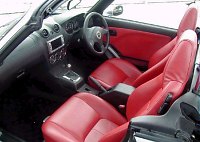|
 Since
Suzuki Cappucino, the Japanese had forgotten how to build a sporty and
fun K-car. Overcrowded in the streets of Tokyo are all
refrigerator-like
boxes. You can hardly name the differences between a Mitsubishi
eK-wagon
and a Honda Life. Now Daihatsu finally injected a new lease of life
into
the K-car segment with the Copen. Since
Suzuki Cappucino, the Japanese had forgotten how to build a sporty and
fun K-car. Overcrowded in the streets of Tokyo are all
refrigerator-like
boxes. You can hardly name the differences between a Mitsubishi
eK-wagon
and a Honda Life. Now Daihatsu finally injected a new lease of life
into
the K-car segment with the Copen.
What makes the
headline is
that Copen is the world’s cheapest car with retractable metal roof.
This
technology was pioneered by Mercedes SLK (Honda CRX Del Sol was Targa
rather
than fully retractable) and has been copied by 206CC, Lexus SC430 and
Mercedes'
own SL. It is increasingly more popular, especially when production
cost
is falling. Last year, Peugeot sold 72,000 units of 206CC. This year
will
approach somewhere around 100,000 units.
 Like
206CC, Daihatsu Copen was first appeared as a concept car (in 1999
Tokyo
motor show). After receiving good reception it got green light and
spent
3 years for development. The folding aluminium roof called for a new
metal
fitting technology to reduce cost (otherwise impossible for a car so
cheap).
Press a button, after 20 second the roof will be completely stored in
the
trunk. With the roof eliminated, it seeks rollover protection from a
pair
of rollover bars located right behind the headrests - very Audi TT
Roadster-like. Like
206CC, Daihatsu Copen was first appeared as a concept car (in 1999
Tokyo
motor show). After receiving good reception it got green light and
spent
3 years for development. The folding aluminium roof called for a new
metal
fitting technology to reduce cost (otherwise impossible for a car so
cheap).
Press a button, after 20 second the roof will be completely stored in
the
trunk. With the roof eliminated, it seeks rollover protection from a
pair
of rollover bars located right behind the headrests - very Audi TT
Roadster-like.
In
fact, many
criticize the
styling of Copen copies that of the TT - you can easily see that from
its
body profile and its six-spoke wheel design. Besides, it also copies
many
details from Volkswagen New Beetle - such as the headlamps and
taillights.
Anyway,
copy cat
saves a
lot of money on design thus might benefit pricing - just joking. In
fact,
it could be cheaper than 206CC because it is a K-car, derived from
Daihatsu
Mira / Move / Max and shared 40% of components, mostly the engine,
transmissions
and suspensions. The 830kg Copen is therefore powered by the company's
660c.c. turbocharged 16-valve four-pot engine, driving either 5-speed
manual
or a Tiptronic-style 4-speed auto to the front wheels. Ridiculously,
the
manual version employs a LSD to handle the "mighty" 64 horsepower and
81
lbft of torque.
To
up chassis
rigidity, wheelbase
has been shortened by more than 100mm while the introduction of
rollover
bars adds rigidity. Floorpan, sills and windscreen pillars have been
strengthened.
 However,
though being cheaper, it won't appeal to the majority like the 206CC.
The
Copen is not as practical as the Peugeot. First of all, the cabin is
cramped,
because its roof is 130mm lower than 206CC. 6-feet people will find
limited
headroom. Secondly, the tiny engine needs rev to overcome turbo lag and
extract sufficient horsepower for brisk acceleration, unlike the 206CC
(even in 1.6 version) which has strong reserve of torque. If not
bounded
by the regulations, I am sure Daihatsu would have seek power from a
bigger
normally aspirated engine, such as the 110hp 1.3-litre from Sirion.
K-car
regulations create many opportunities, but also ruin some good attempts. However,
though being cheaper, it won't appeal to the majority like the 206CC.
The
Copen is not as practical as the Peugeot. First of all, the cabin is
cramped,
because its roof is 130mm lower than 206CC. 6-feet people will find
limited
headroom. Secondly, the tiny engine needs rev to overcome turbo lag and
extract sufficient horsepower for brisk acceleration, unlike the 206CC
(even in 1.6 version) which has strong reserve of torque. If not
bounded
by the regulations, I am sure Daihatsu would have seek power from a
bigger
normally aspirated engine, such as the 110hp 1.3-litre from Sirion.
K-car
regulations create many opportunities, but also ruin some good attempts.
Surprisingly,
the
relaxed-looking
Copen has very stiff suspension setup. This make it a good driver’s car
by K-car standard, but the side effect is uncomfortable and noisy ride
on bumpy roads. It is therefore not as competent as Cappucino. 10 years
gone, Cappucino remains to be the most lovely K-car.
|